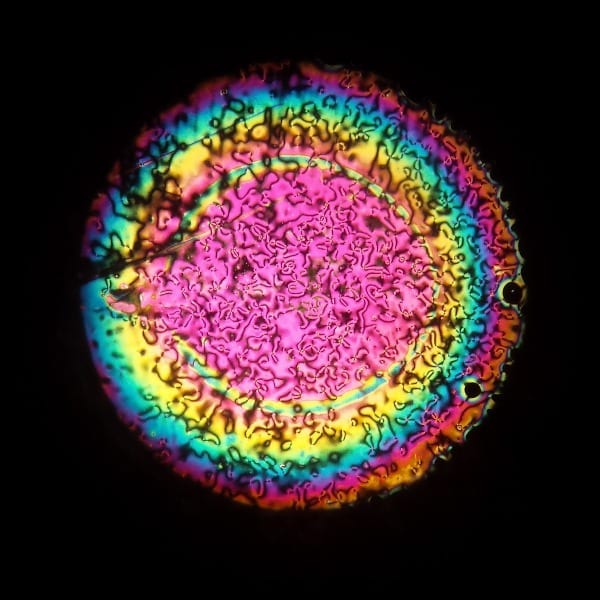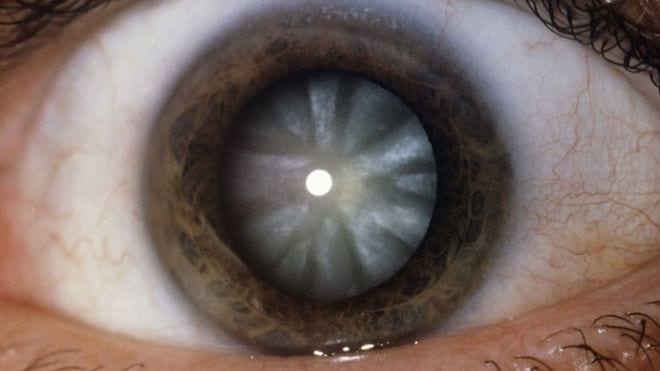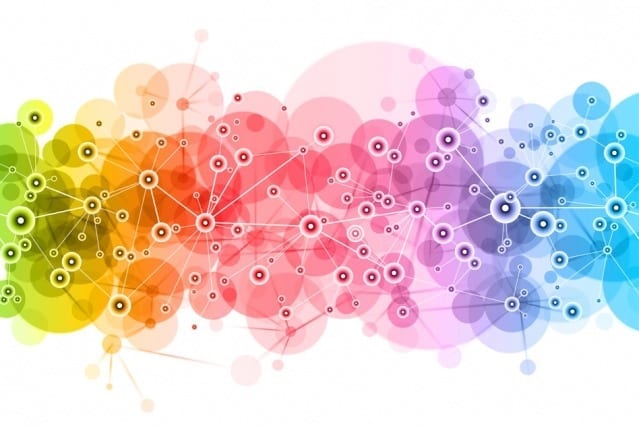
A University of Leeds researcher is developing a new eye lens, made from the same material found in smartphone and TV screens, which could restore long-sightedness in older people.
As people age, their lenses lose flexibility and elasticity. This leads to a condition known as presbyopia, common in people over 45 years old, and can require optical aids, such as reading glasses.
Devesh Mistry, a postgraduate research student in the School of Physics and Astronomy, is now working with liquid crystal to create a truly adjustable artificial lens.
He said: “As we get older, the lens in our eye stiffens, when the muscles in the eye contract they can no longer shape the lens to bring close objects into focus.”
“Using liquid crystals, which we probably know better as the material used in the screens of TVs and smartphones, lenses would adjust and focus automatically, depending on the eye muscles’ movement.”
Using these liquid crystal-based materials, Devesh’s research is developing synthetic replacements for the diseased lens in the eye – a new generation of lenses and intra-ocular lens implants to rejuvenate sight.
Devesh is currently researching and developing the lens in the lab and aims to have a prototype ready by the end of his doctorate in 2018.
Within a decade, the research could see the new lens being implanted into eyes in a quick and straightforward surgical procedure under local anaesthetic.
Eye surgeons would make an incision in the cornea and use ultrasound to break down the old lens. The liquid crystal lens would then be inserted, restoring clear vision.
The lens could also have application in tackling cataracts – the clouding of natural lenses – which affect many people in later life and which can seriously affect vision. A common treatment is to remove and replace the natural lens.
“Liquid crystals are a very under-rated phase of matter,” Devesh told The Times, “Everybody’s happy with solids, liquids and gases and the phases of matter, but liquid crystals lie between crystalline solids and liquids. They have an ordered structure like a crystal, but they can also flow like a liquid and respond to stimuli.”
Read more: Is the end in sight for reading glasses?
The Latest on: Eye lens
[google_news title=”” keyword=”Eye lens” num_posts=”10″ blurb_length=”0″ show_thumb=”left”]
via Google News
The Latest on: Eye lens
- Contact lenses vs. glasses: Which is better for eye health?on April 28, 2024 at 2:30 am
Choosing between glasses and contacts depends on lifestyle, budget, and eye health concerns. Regular eye exams are crucial for optimal vision correcti ...
- Best anti-aging eye creams to help you turn back the clockon April 26, 2024 at 8:57 pm
Our guide to the best anti-aging eye creams will help you to rejuvenate the skin around your eyes and reduce the signs of aging, with clinically proven results.
- Zenni just unveiled blue-light blocking lenses that are actually stylishon April 26, 2024 at 2:36 pm
Following up its most recent launch of an all-in-one eye protection lens, dubbed EyeQLenz, Zenni is back with an exciting new lens designed to filter out blue light for screen users (read: all of us).
- Contact Lenses Market, Projected to Reach US$ 16,256.8 Million by 2034: A Detailed Analysis of Growth Factors, Consumer Trendson April 25, 2024 at 9:53 pm
In 2024, the global contact lenses market is estimated to be valued at US$ 10,035.9 million, with projections indicating a growth to US$ 16,256.8 million by 2034. Over the forecast period, the demand ...
- Eye-care practice opens in-office surgery clinic for cataractson April 25, 2024 at 12:55 pm
Dr. Alla Golovkina-Hynes, who opened Eye Care Physicians and Surgeons in 2011, specializes in cataracts and regularly performs cataract surgeries at the Winchester Medical Center and the Shenandoah ...
- Viltrox announces AF 40mm F2.5 Z, a full-frame autofocus prime lens for Z-mounton April 25, 2024 at 7:16 am
The small, lightweight prime lens features internal focusing and EXIF communication with Nikon Z-mount cameras. (Includes sample gallery.) ...
- The AI camera stripping away privacy in the blink of an eyeon April 25, 2024 at 7:00 am
A new camera called NUCA uses artificial intelligence to create deepfake photos of subjects by stripping away clothing in close to real time.
- Utah eye surgeon explains what you need to know when thinking about LASIKon April 18, 2024 at 12:04 pm
If you're considering LASIK, Katherine S. Hu, MD, a top vision correction surgeon at the John A. Moran Eye Center at the University of Utah has some advice.
- What to Expect From Cataract Surgeryon April 17, 2024 at 5:00 pm
The lens, a normally clear part of your eye located just behind the colored iris, helps your eye focus light. As cataracts develop, they blur your vision and can make it hazy and less colorful ...
- Behind the Lens: Rock climbing and photographing the eclipse during totalityon April 17, 2024 at 9:39 am
As the moon blocked out the sun in the mid-afternoon of April 11, most viewers craned their necks upwards. But FOX 2 photographer Coulter Stuart had something else in mind: ...
via Bing News










